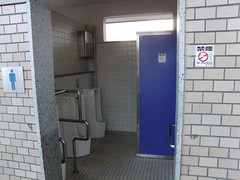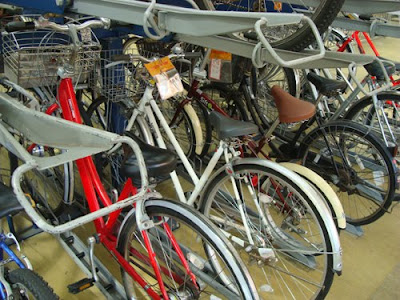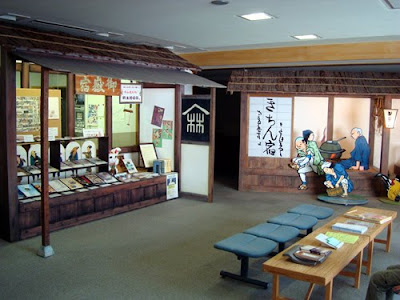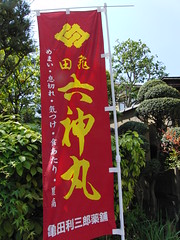国鉄労働組合 JR

The wheels of the system turn very, very slowly in Japan - and the newspapers today carry the story of the conclusion of a dispute that has been going on for 23 years.
The National Railway Workers' Union (NRU, or "Kokuro") is a railway workers' union that
protested heatedly against the 1987 privatization of Japan Rail. Pigheadedness in the leadership of both JR and the NRU led to an insoluble standoff between the two, and when Japan Rail was reborn in 1987 out of the old Japanese National Railways, NRU workers found themselves sidelined to largely meaningless jobs. Continued lack of attempts by the union to compromise with Japan Rail led ultimately to the mass desertion of over 200,000 NRU members, leaving the NRU a shell of its former self. However, many members remained, and, ultimately, 5009 NRU members remained unemployed by JR - most of them in the economic backwaters of
Kyushu and
Hokkaido. Over 200
committed suicide. On the other hand, most of those who quit the union found employment in JR.
Meanwhile, the other unions (the two biggest had merged) denounced the NRU, and opposed the employment by JR of any of its members. Most remaining NRU members were relegated to non-rail-related jobs such as manning station kiosks and stalls, servicing vending machines, and the like. (However, by the beginning of 2005, most of the them had got their old, more solid, posts back.)
In 1994, JR dropped its suit for damages against the NRU (it had reached a similar solution with the other unions at the time of privatization) in exchange for the NRU vacating its premises in favor of the JNR Settlement Corporation (which dissolved in 1998), a deal arranged by Minister of Transport at the time, Shizuka Kamei. The JNR Settlement Corporation itself, was, in effect, something of a holding pen for the NRU members who had not found employment in the new JR. The money given to the NRU in exchange for its vacating of its premises was widely held to be, in effect, a payment for a solution to the long-running stand-off. The sum paid was undisclosed.
Upon the dissolution of the JNR Settlement Corporation, the 1047 NRU members left formed a nationwide network of 36 "NRU Struggle Groups," which together sued JR at the District Labour Relations Commission, which ruled in favor of the union. However, JR fought back, with the support of the other (pro-JR) unions, which even threatened to strike in protest if NRU members were employed. The suit was eventually overturned by the Supreme Court in 2003, which ruled in favor of JR.
However, the indefatigable NRU Struggle Groups sued again, this time sued the successor to the JNR Settlement Corporation, the Japan Railway Construction Public Corporation (whose role has now been taken over by the Japan Railway Construction, Transport and Technology Agency) for "discriminatory hiring practices" in its allocation of work in JR to its members. The court only partially accepted the claim, and, although it awarded damages, the still disgruntled NRU Struggle Groups appealed.
By 2000, cracks were starting to show within the NRU leadership, and the three parties in power at that time, together with the Socialist Party, agreed to seek a payment to the union from JR in return for the NRU recognizing that JR had no legal liability to pay its members damages, as the Supreme Court had determined. The NRU rejected this, as it offered no guarantee of payment, but only a promise to try and get payment.
Severe internal friction on the NRU side was now apparent. The NRU conflicted with the NRU Struggle Groups, which had filed itsuit against the the Japan Railway Construction Public Corporation independently of the NRU proper. However, following a 2005 ruling by the Tokyo District Court that partially defended the NRU against JR, NRU unity was restored in 2006. In its ruling, the Tokyo District Court awarded the plaintiffs damages of 5 million yen each, but because the court ruled that the Japan Railway Construction Public Corporation was not responsible for rehiring them, the NRU appealed.
In 2008, the Tokyo District Court ruled in favor of the Japan Railway Construction Public Corporation.
Today, the government announced a brokered settlement with the NRU of a 22 million yen (about USD240,000) payout to each aggrieved NRU member, conditional on recognizing that the government does not guarantee them a job with JR. As of the 17th, 904 of the 910 plaintiffs had accepted the sum.
The initial award having been 5 million yen each, there is now widespread public murmuring and eye-rolling over the 22 million each plaintiff has now received. It is seen as the result of
gonetoku (ごね得).
gone is the noun form of the verb
goneru, meaning to incessantly and insistently grumble, and the
toku (from the verb
tokusuru) means to gain or profit. In other words, complain long and loud enough and you'll get what you want, or "the squeakiest wheel gets the oil."
The case is long and complex - the above narrative is a summary only - and replete with personal and organizational frustrations and tragedies. The plaintiffs are now at least in their 40s (see photo at top of NRU members protesting in 2008), and have probably spent the main part of their careers feeling wronged and embittered. Over 200 of them have already taken their own lives. Even with the money, their crux of the dissatisfaction: unfair treatment, remains unresolved.
Were the initial fears of the NRU concerning the privatization of the national railways justified? Did they not become a self-fulfilling prophesy? Could JR have more effectively quieted those fears at the beginning? Did the NRU's original leaders perhaps have a self-interested hand in fanning them?
On the other hand, many of the members of other unions who accepted the privatization of JR are now probably equally embittered that their compliance and cooperation has been eclipsed by this rewarding of the NRU members' belligerence.
Read about trainspotting in Japan© JapanVisitor.com
Yahoo Japan Auction ServiceBook a Japanese Hotel with BookingsJapanese FriendsJapan Job SearchTokyo ViceTagsJapan JR NRU Nagoya Japanese





































